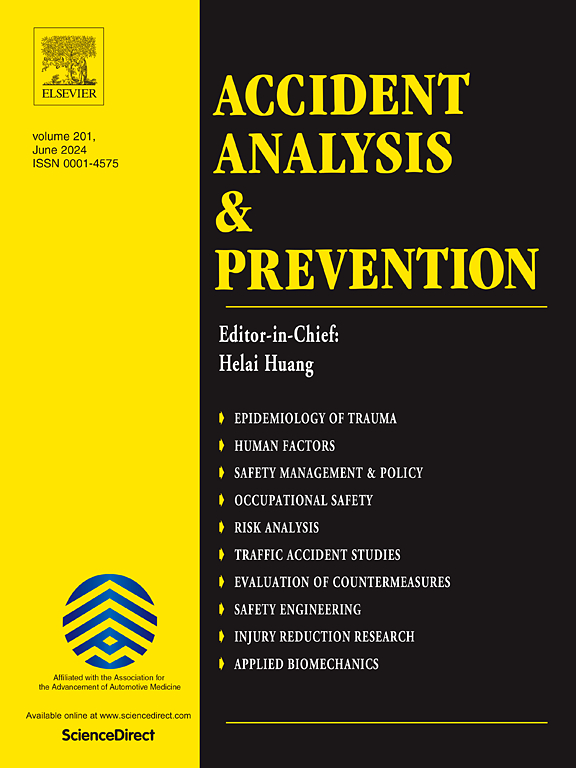Modeling dilemma zone at urban signalized intersections using crowdsourced trajectory data
IF 6.2
1区 工程技术
Q1 ERGONOMICS
引用次数: 0
Abstract
The stop/go dilemma drivers face at the yellow onset is highly correlated with the potential risks of rear-end collisions and red-light running crashes. This dilemma has been physically characterized using the Type I and Type II definitions. Unlike the Type II definition with several limitations, the Type I counterpart incorporates the dynamics of driver-vehicle attributes to quantify the dilemma zone accurately but requires high-quality vehicle trajectory data. Such trajectory data in existing studies are extracted from field-setup video cameras or radar, undergoing manual trajectory reduction and labor-intensive data processing challenges. Moreover, accurate modeling of the Type I dilemma zone dynamics and accuracy evaluation with the Type II methods remain major research gaps in the existing literature. This study addresses these gaps and challenges by accurately quantifying the Type I dilemma zone using a large sample of crowdsourced vehicle trajectory data. Quantile regression is implemented to capture the dynamics of individual driver-vehicle attributes directly into the minimum stopping and the maximum clearing distances. Results across 15 intersection approaches consistently showed that the Type I dilemma zone is created if vehicles approach at a very high speed. Accuracy evaluation yielded low root mean squared errors of 14.8 ft and 25.1 ft in estimating the start and end of zone boundary, demonstrating the proposed method’s superiority over other dilemma zone quantification methods. Besides boundary comparison, driver behavior at the approach area is analyzed to understand potential rear-end and right-angle collision risks. This study advances our understanding of dilemma zone boundary dynamics and provides a sound empirical basis to support the development of efficient dilemma zone protection and signal timing strategies to improve intersection safety.
基于众包轨迹数据的城市信号交叉口困境区建模
驾驶员在黄灯开始时面临的停/走困境与追尾碰撞和闯红灯碰撞的潜在风险高度相关。这种困境已经用I型和II型定义进行了物理表征。与具有若干限制的II型定义不同,I型对应的定义结合了驾驶员-车辆属性的动态,可以准确地量化困境区,但需要高质量的车辆轨迹数据。在现有的研究中,这些轨迹数据是从现场设置的摄像机或雷达中提取的,经历了手动轨迹缩减和劳动密集型数据处理的挑战。此外,第一类困境区动态的准确建模和第二类方法的准确性评估仍然是现有文献的主要研究空白。本研究通过使用大量众包车辆轨迹数据样本,准确量化I型两难区,解决了这些差距和挑战。分位数回归实现了将单个驾驶员-车辆属性的动态直接捕获到最小停车距离和最大清除距离中。15个交叉口进路的结果一致表明,如果车辆以非常高的速度进路,则会产生I型两难区。准确度评估在估计区域边界的开始和结束时产生了较低的均方根误差,分别为14.8 ft和25.1 ft,表明该方法优于其他困境区量化方法。除了边界比较外,还分析了接近区域的驾驶员行为,以了解潜在的追尾和直角碰撞风险。该研究促进了我们对两难区边界动力学的认识,为制定有效的两难区保护和信号配时策略以提高交叉口安全性提供了良好的实证依据。
本文章由计算机程序翻译,如有差异,请以英文原文为准。
求助全文
约1分钟内获得全文
求助全文
来源期刊

Accident; analysis and prevention
Multiple-
CiteScore
11.90
自引率
16.90%
发文量
264
审稿时长
48 days
期刊介绍:
Accident Analysis & Prevention provides wide coverage of the general areas relating to accidental injury and damage, including the pre-injury and immediate post-injury phases. Published papers deal with medical, legal, economic, educational, behavioral, theoretical or empirical aspects of transportation accidents, as well as with accidents at other sites. Selected topics within the scope of the Journal may include: studies of human, environmental and vehicular factors influencing the occurrence, type and severity of accidents and injury; the design, implementation and evaluation of countermeasures; biomechanics of impact and human tolerance limits to injury; modelling and statistical analysis of accident data; policy, planning and decision-making in safety.
 求助内容:
求助内容: 应助结果提醒方式:
应助结果提醒方式:


